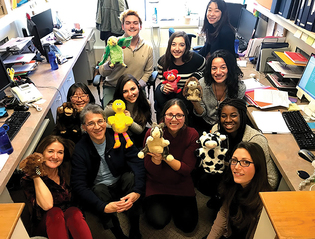
Katarzyna Chawarska
Shown here are members of Yale’s Social and Affective Neuroscience of Autism Program, along with Cheryl Henson ’84 (bottom left) and Z. Briggs (center foreground, with bunny) of the Jim Henson Foundation.
Henson had contacted child psychiatry professor Katarzyna Chawarska, who directs the autism program. (Chawarska isn’t visible; she took the photo.) The result: an experiment with kids and puppets that may help autistic children in the future.
View full image
Puppets: “What’s not to like?” It’s a lighthearted question that Katarzyna Chawarska ’00PhD, professor of child psychiatry at the Yale School of Medicine, takes seriously.
Chawarska works with children who have autism spectrum disorder. These are children who struggle to express the things they want or need, who don’t always pay attention to or properly interpret nonverbal social cues—the raised eyebrow or other gestures. These are children who more often than not disengage from the social world around them. Might puppets, acting as social partners, Chawarska wondered, help them reengage?
Cheryl Henson ’84, president of the Jim Henson Foundation, had wondered the same thing. So, working with puppets provided by the Henson Foundation, Chawarska undertook an experiment to find out. Thirty-seven children with varying degrees of autism severity watched a short video in which a person and a puppet talked and played together. Another group of 27 children with typical cognitive development also watched the video. Chawarska used an eye-tracking method to monitor how the attention of each group focused or wandered.
Given an abundance of prior research on attention to human speakers, Chawarska felt confident that children with autism would spend less time than typical children looking at the human actor. Of interest, though, was how they would respond to the puppet: would they spend more time looking at the puppet than the “control” group—engrossed, perhaps, by the puppet’s unusual features? Would they spend less time than the other children, demonstrating the same lack of interest in talking puppets as talking people?
“It turned out neither of those hypotheses was true,” Chawarska says. “When looking at puppets, the patterns among kids with autism were comparable to what we observed in typical children.” Not only that, but the severity of autism symptoms had no notable effect on the results. Typically, children with severe autism are more difficult to engage. But that wasn’t true with the puppets.
Several new research avenues emerge from these findings, but from a practical angle, Chawarska hopes they can inform more-effective therapeutic interventions designed to teach autistic children social communication skills. What, precisely, this would look like requires getting good puppeteers and good therapists in the same room to talk through possibilities; but the empirical rationale supporting such an endeavor now exists.
Of particular interest, Chawarska says, is the way in which using puppets during therapy may spark engagement among autistic children. Puppets, she notes, tend to inspire a lot of smiling and laughter and general positive emotion in people. Positive emotion, in turn, releases dopamine, which is important to processes such as learning, memory, and motivation. If puppets can make children with autism happy, that could suggest a distinct capability for teaching.
“This potential to elicit joy among children with autism is a very important ingredient,” Chawarska says. “That would enhance the children’s motivation to engage—and, perhaps, facilitate how well they learn in a therapeutic context.”
 loading
loading